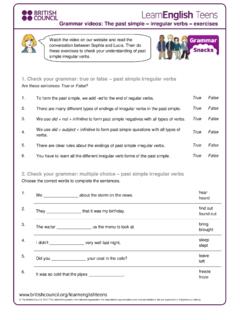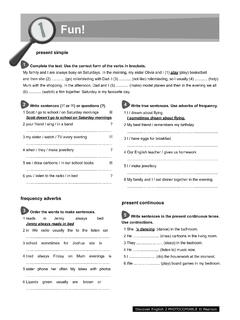Transcription of Activity—World Map of Plate Boundaries
1 E-binder for 2013 CEETEP workshop 69 Activity World Map of Plate Boundaries Where s Waldo -style World Plates helps students connect topography, earthquakes, volcanoes, and many maps for printing, and student worksheets. Color copies are in the folder: 4. ACTIVITIES_Earth & Tectonics > World Plate BoundariesVIDEOS: In the folder 3. VIDEOS_Earth & Tectonics > LECTURE_Egg Vs , , , Or online: : Select animations are in the RESOURCES folder for this activity. 3. Animations_Earth & Tectonics > Plate Interaction_Converge Diverge Transform Or online: : This Dynamic Planet, interactive tectonic map on this DVD & Internet for World Map of Plate BoundariesScience StandardsSystems Cycles in Earth Science Evidence of Change Science, Technology & Society Predictability & Feedback Evolution of the Earth SYMBOLSW hite arrows show Plate motion directionVolcanoes (generalized) Hot spot (arrow = direction of Plate motion)Great earthquakes since 1900; before 1900 Divergent margin Convergent marginTransform fault (arrows show relative motion) Plate BOUNDARIESMost of the world s earthquakes and volcanoes are found at or near the boundary between two tectonic plates.
2 Friction between the plates keeps them from sliding. When the frictional strain is overcome, the ground suddenly snaps along faults and fractures releasing energy as earthquakes. Volcanoes occur at divergent margins (where magma rises and erupts); at convergent margins (where an oceanic Plate dives beneath another Plate ; magma forms in the continental Plate above the diving oceanic Plate ), and less commonly as hot spots (where magma melts through a Plate , such as Hawai`i).70 Introduction The Plate Tectonics Mapping Activity allows students to easily begin to identify basic tectonic processes on a global scale. As students become aware of Plate movements, they begin to identify patterns that set the stage for deeper understanding of a very complex topic. The activity uses a simple Where s Waldo approach to identify tectonic symbols on a laminated World Plate Tectonic map.
3 ObjectivesLearn where volcanoes and earthquakes occurUnderstand geographyUse critical thinking to find Plate boundariesAnswer relevant discussion questions on worksheetProcedurePrint the appropriate maps (see Materials) for use. Note that the maps in this document need to printed on legal-size paper!!Students work in pairs or small groups of 3 or 4 students using washable markers to circle tectonic features. This hands-on activity captures the interest of all ability levels. The process of exploring the map and drawing with colored markers captures student interest and creates curiosity to discover why particular features are located where they are. As students work through simple questions on the activity sheet, they are then able to start the more challenging process of understanding the patterns and process that make up the fundamental principles of Plate Tectonics.
4 The Discussion Questions in the activity are provided as a resource for teachers to engage student s growing understanding. The questions have been used in small groups, whole class discussion, research, as a writing assignment, and for Questions On page work sheets Begin on page 5 of this document; answers follow. Word files of the worksheets are in the folder RESOURCES For World Plate Boundaries > Word Docs for World Plate BoundariesMaps The map on the next page is offered in several formats for classroom use. Since not everyone has access to a large-format printer we offer the poster as a 3-page, tabloid-size pdf file that can be printed and taped together. The maps are also offered WITHOUT tectonic Boundaries to be used to see if students recognize features in the ) Page size (next page) and on DVD in the folder: RESOURCES For World Plate Boundaries Maps for printing > ) Poster (14x24) requires a plotter to print WorldTectonicMap_POSTER ) Poster (tabloid-size pages to be taped together) ) WITHOUT tectonic features to be used to see if tectonic features show up in the landscape: Map of Plate Boundariese-binder for 2013 CEETEP workshop 71 SYMBOLSW hite arrows show Plate motion directionVolcanoes (generalized) Hot spot (arrow = direction of Plate motion)Great earthquakes since 1900.
5 Before 1900 Divergent margin Convergent marginTransform fault (arrows show relative motion) Plate BOUNDARIESMost of the world s earthquakes and volcanoes are found at or near the boundary between two tectonic plates. Friction between the plates keeps them from sliding. When the frictional strain is overcome, the ground suddenly snaps along faults and fractures releasing energy as earthquakes. Volcanoes occur at divergent margins (where magma rises and erupts); at convergent margins (where an oceanic Plate dives beneath another Plate ; magma forms in the continental Plate above the diving oceanic Plate ), and less commonly as hot spots (where magma melts through a Plate , such as Hawai`i).72 Mountains & valleysSpreading center FastSpreading center SlowDivergent Boundaries occur mostly along spreading centers where the magma rises forming new crust.
6 (Ex. East Pacific Rise, Mid Atlantic Ridge.)Spreading zones (no graphic) on continents create parallel mountains and valleys as the crust pulls apart (ex: Basin & Range, and the Great Rift Valley, Africa. )Divergent Boundaries & Spreading ZonesLithosphereAsthenosphereOceanic crustMantlePartial meltAsthenosphereCrustMantleLithosphereP artial meltConvergent BoundariesMountain RangeOld oceanic crustContinental crustHighPlateauContinental crustLithosphereLithosphereAsthenosphere TrenchOceanic crustContinental crustLithosphereLithosphereAsthenosphere AsthenosphereIsland arcOceaniccrust When two plates move toward each other, crust is destroyed as one Plate dives (is subducted) beneath the other. The location where sinking of a Plate occurs is called a subduction Ocean Plate dives beneath another ocean Plate ; volcanic island chain forms above the zone (ex.)
7 The Marianas)Ocean-Continent: Ocean Plate dives beneath a continental Plate . Volcanic mountain chain forms inland. (ex:. Cascade Range, Sumatra, Japan)Continent-Continent: Two thick continental plates collide and buckle into high mountains. (ex: Himalaya Mountain Range.)TrenchContinental crustLithosphereLithosphereAsthenosphere Volcanic crustTransform BoundariesAs surrounding plates are driven by deep forces to move apart or crunch together, the in-between areas are pushed around on the surface. This forces them to slide past each other faults are where two plates are moving away from a spreading ridge and fracture zones develop (ex: ocean floor)AsthenosphereCrustLithosphereAsthe nosphereCrustTransform faultLithosphereSpreading ridgePartial meltSpreading ridgeStrike slip faults result from two plates moving horizontally in opposite directions (ex: San Andreas Fault, California).
8 E-binder for 2013 CEETEP workshop 73 Name_____Period_____ Date_____ Plate TECTONICS MAPPING ACTIVITY1. Draw the symbol for each tectonic feature in the chart belowDivergent margins and spreading centers (draw in black) Convergent margins - subduction zone (draw in blue)Transform faults strike-slip faults (draw in green)Hot Spot (draw in red)2. Use the correct color of washable marker to locate each tectonic feature on the map. a. Circle the name of the Divergent boundary systems in black. (Ridges and Rises) Number found _____ b. Circle the Convergent margins in blue. (students may circle individual trenches) Number found _____ c. Circle the Transform fault symbols (and their faults) in green.
9 Number found _____ d. Circle the Hot Spots in red. Number found _____3. What is the name of the small crustal Plate off the Oregon coast that is subducting under the North American Plate ? _____4. Where are most of the earthquakes and volcanoes located? Check one: a. crustal Plate margins _____ b. interior of a crustal Plate _____ Answer the following questions about Plate Tectonic Processes using the diagrams with the Divergent margins and continental spreading centers: a. New crust forms at Plate margins as _____ rises creating ridges under oceans such as the _____ and the _____. 74 b. Continental spreading centers include the _____ in the US and the _____ in Convergent margins subduction zones: Identify the land form (geomorphology) created at each type of Convergent Boundary and provide an _____a.
10 Ocean-Continent _____b. Continent-Continent _____c . 7. Transform faults strike slip faults a. Sometimes tectonic plates shift past each other horizontally _____ directions at their boundary. b. One example of a strike slip fault near San Francisco is the Earthquakes: Most earthquakes occur near Plate _____ keeps the Plate edges from sliding smoothly past each The longer the plates remain stuck, the more strain builds and the more violent c . the snap and resulting Volcanoes: a. Magma rises to the surface from inside the earth mainly at _____ and the rim of the Pacific Ocean, the 40,000 km long _____ of _____ b. is especially Hot Spots:In a few places _____ melts through a tectonic Each hot spot likely marks the top of a plume of _____ rock that risesb. from deep in the for 2013 CEETEP workshop 75 b.





